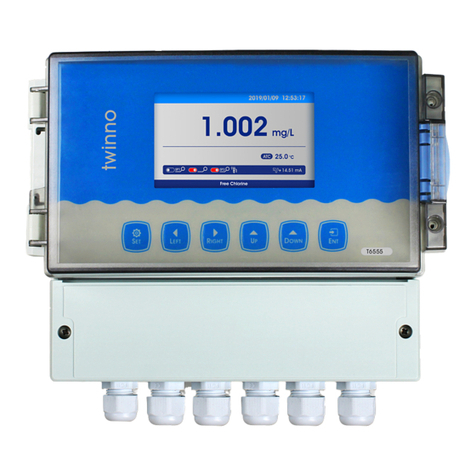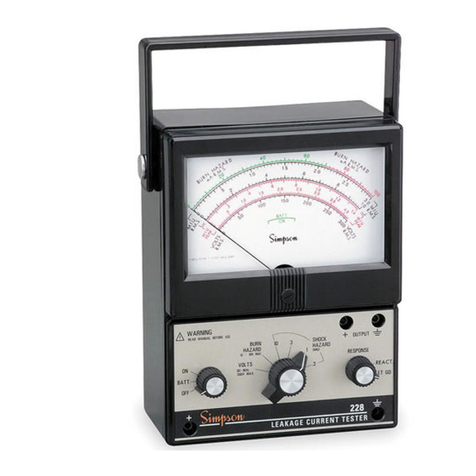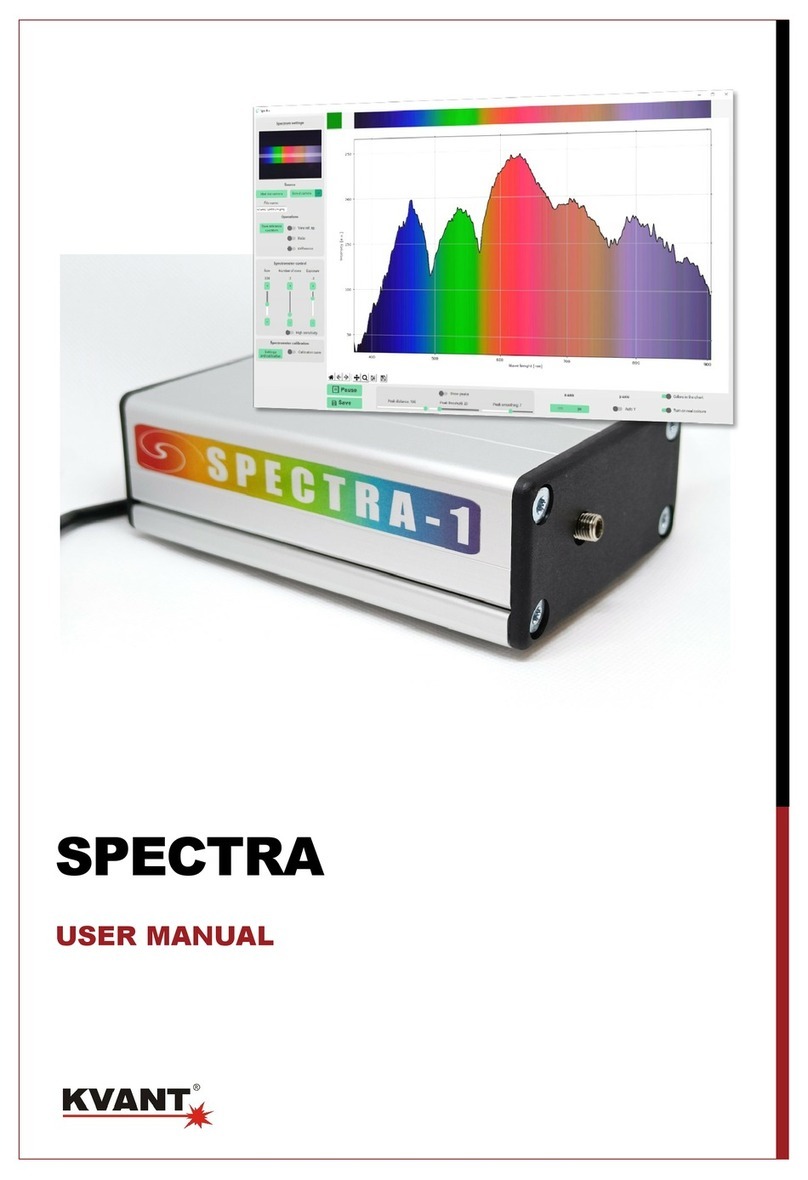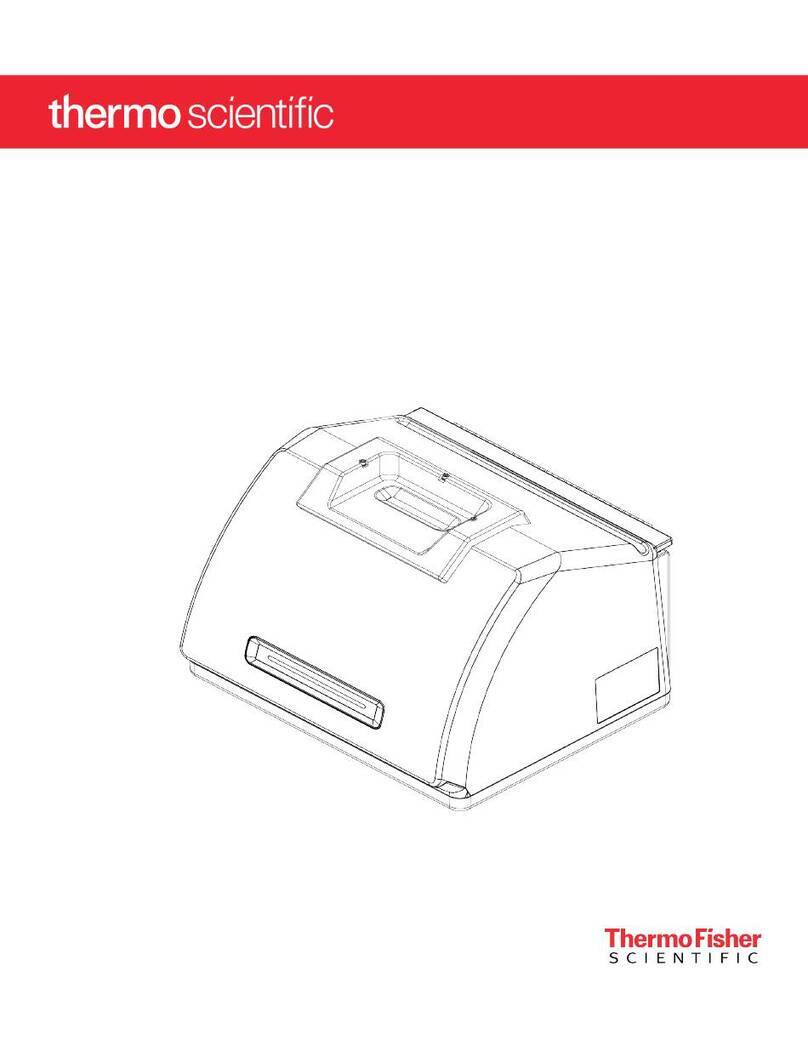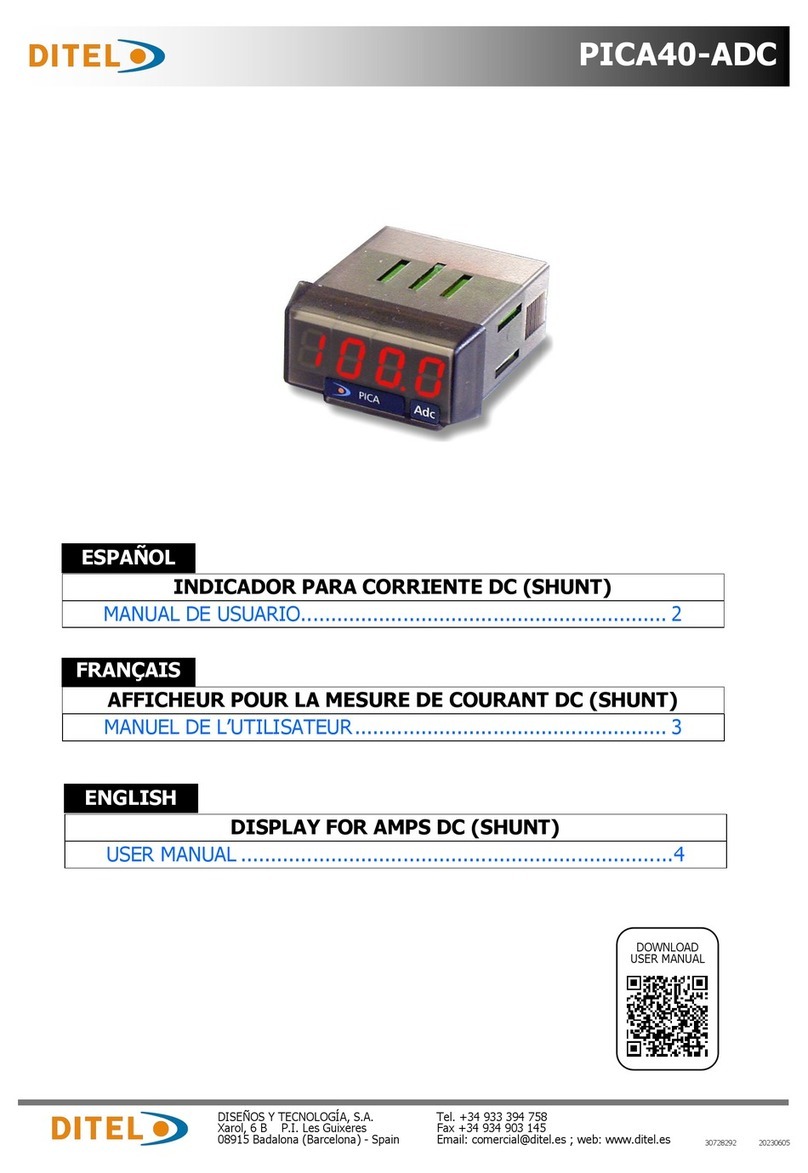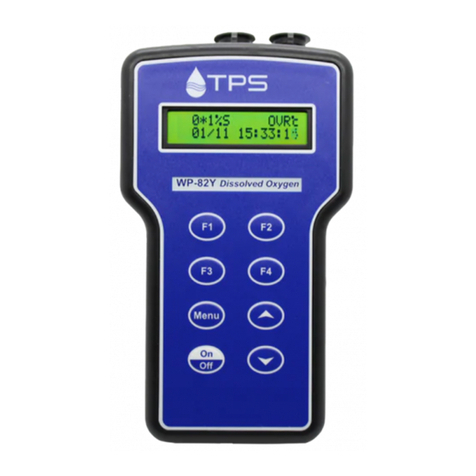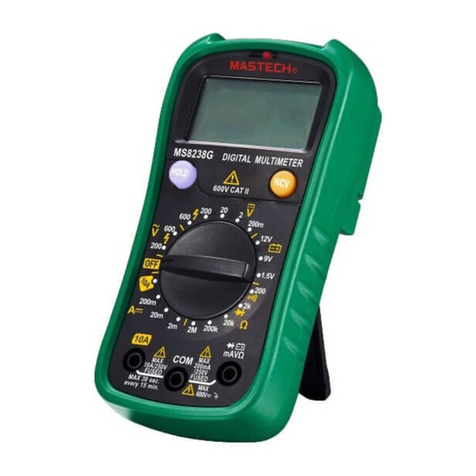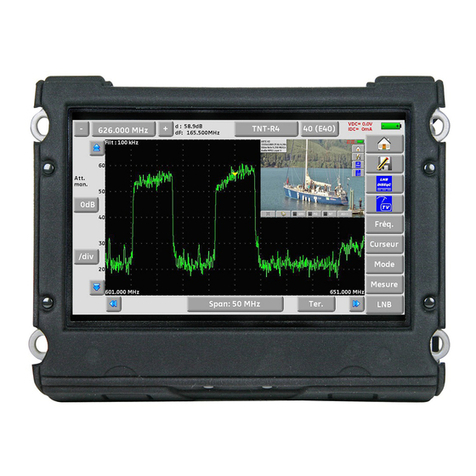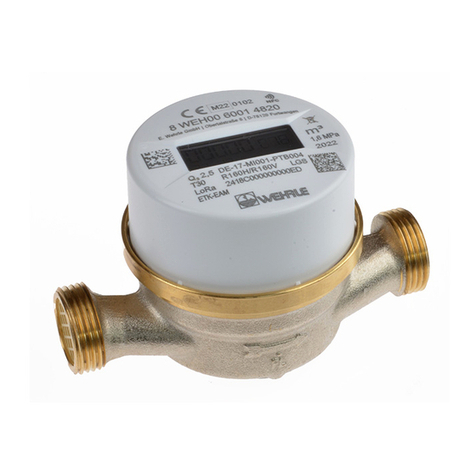CRUISING ELECTRONICS E-Meter User manual

Graphic and Digital Displays!
The
Ultimate
battery monitor for...
...Marine Systems
...Alternative Energy Systems
...Recreational Vehicle Systems
...Industrial Lift Truck Applications
...Electric Vehicles and many more!
The world's most accurate
state-of-chargemonitor!
Copyright 1995-1998 Manual Part # 890015 Rev.5D 1/15/98
Owner's Manual
EINSTAL5D.PM6
Patented

2
Help Index
Advanced Functions, 30-38
Battery Basics, 8
CE Declaration of Conformity, 51
Charge Efficiency Factor, 23
Charged Parameters, 22-23
High Voltage Notes, 50
Historical Data, 29
Installation (General), 9-15
Introduction, 7
Low Battery Alarm, 27, 35-38
Low Voltage, 27
Meter Wiring Detail, 14
Mounting, 10
Operation (Basic), 18-24
Options and Versions, 44
Peukert’s Equation, 26, 39-42
Prescaler (optional), 45
Quick Reference Guide, 5-6
Reading the Bar Graph, 19
Removing, 11
Reset and Lock, 28
Serial Port, RS-232(optional), 49
Setting Battery Capacity, 21
Setting Peukert's Exponent, 26
Setting Up t , 24
Shunt & Battery Wires, 13
Specifications, 3
Start Up, 16
Synchronizing Your Meter, 17
Temp. Sensor (optional), 25
Troubleshooting, 43
Using the Buttons, 20
Warranty Support, 52
Wire by Wire Check, 15
Wiring Overview, 12
DONOTINSTALLORUSETHISPRODUCTUNTILYOUHAVEREAD
THE ENTIRE OWNER’S MANUAL. IMPROPER INSTALLATION OF
THISUNITMAYBEHAZARDOUSANDVOIDSYOURWARRANTY.

3
Specifications
Voltage:For 12V - 24V systems. Optional Prescalers extend voltage range.
Standard Model: Two Auto-ranges: 0 to 19.95V (0.05V resolution)
20.0to50.0V(0.1Vresolution)
Optional Prescalers: 0-100V, 0-500V (Used with standard model)
Amperage:
Low Range: + 0 - 40.0 Amps (0.1 Amp resolution)
High Range: + 500 Amps (1 Amp resolution)
Amp-hours:
Low Range: +0 - 199.9 Amp-hours (0.1 Amp-hour resolution)
High Range: + 200 - 1999 Amp-hours (1 Amp-hour resolution)
Time Remaining:
Low Range: 0 to 199.9 Hours (0.1 hour resolution)
High Range: 0 to 255 Hours (1.0 hour resolution)
PowerRequirements:
9.5-40 Volts DC
Current: 50-150mA(DependsonAmbientlight.DisplayAutoDims.)
28 mA (Sleep Mode - Bar Graph Display Only)
Shunt type required: 50 mV @ 500 Amp
Accuracy:Voltage: + (0.6% of reading + 1 least count of resolution)
Amperage: + (0.8% of reading + 1 least count of resolution)
Amp-hours: Ahr Error ~ (Time of measurement x current error)
Physical: Max. Outer Bezel Diameter: 2.5 inches (63.5mm)
Max. Barrel diameter: 1.95" (50mm)
Max. Depth: (from back of bezel) 3.15 inches (80mm)
Hole Cutout Size: Use 2" or 2 1/16" hole saw (52mm)
Water Resistance: Splashproof front panel.
Weight: 8 Ounces (227g)
V
t
A
Ah

4
Top Rear View of Meter
-DC Meter Negative (BLACK) [1]
Shunt Sense Lead Load Side (GREEN) [2]
Shunt Sense Lead Battery Side (ORANGE) [3]
Battery Volt Sense (0-50V DC1) (BLUE) [4]
+DC Meter Power (9.5-40V DC) (RED) [5]
Optional Temperature Sensor Input [6]
Optional Low Battery Alarm [7]
Optional Temperature Sensor Ground [8]
SYSTEM POSITIVE
SYSTEM NEGATIVE
1234567
1234567
1234567
1234567
1234567
Twisted pair wire is used for shunt
sensing leads for noise immunity.
Battery Compartment
+-
2 Amp
Fuses
Your Meter works
with flooded or gel
lead-acidbatteries
Basic Wiring Diagram
The 500 A 50mV
shunt senses cur-
rent in or out of
your battery.
Meter Location
+-

5
Quick Reference
Full
80-99% +
60-79%+
40-59%+
20-39%+
0-19%+
EMPTY
FULL
The Light Bar
The light bar shows state-of-charge at a glance.
Here's what the lights mean:
When you press the button, you
SELect a numeric display. In normal
operation, each press illuminates a sta-
tus light. The light indicates Volts
are being displayed, the light indi-
cates Amps, indicates Amp-hours,
and indicates Time. We’ll explain
these terms on the next page.
The Button
For shortest charging times,
leadacid batteryinmarineor
RV service is normally dis-
charged 50% then recharged
to 85-90% of full. Restoring
thelast10-15%of afullcharge
requiresalongtime-typically
2 - 3 hours. This means only
35-40%ofyourbatterycapac-
ity is actually available for
normaluse. Occasionally dis-
chargingabatterymoredeeply
is perfectly acceptable.
Status Lights
Shows what number is
being displayed

6
Voltsiselectricity’spoten-
tial to do work. Voltage
helps assess approximate
state-of-charge and to
checkforpropercharging.
A 12V battery is consid-
ered 100% discharged
when it drops below
10.5V.
Amps is the present flow
ofcurrentinoroutofyour
battery.Forexample,are-
frigerator may draw 6.2
Amps of current. This is
displayed as -06.2 (6.2
Amps are being con-
sumed).
Time is an estimate of
how long your battery
will sustain a load. A
Time display of 3.7
hours means you have
approximately 3 hours
42 minutes of operat-
ing time remaining.
Amp-hoursconsumed
represents the amount
of energy removed
fromthe battery. Ifyou
run a 10 Amp load for
one hour, Your Meter
will show -10.0 in the
display.
Volts
Amps
Time
Amp-hours
Press and hold the
SET button for 3 sec-
onds to enter the Set
Up and Advanced
Functionsmode.SEL
appearsinthedisplay.
Advanced Functions
KeyAdvancedFunctions
Set Up Features
Advanced
Functions:
CustomizesYour
Meter's functions.
For details read
pages 29-30 and
pages 34-37.
Locks front
panel.
Shows charging
efficiency and
historical data.
ResetsAmp-hours (AH)
or(ALL)defaults.
F01 Scanning
F02 Sleep Mode
F09 Discharge Floor
F15 S/WVersion
F17 Test Lights
Quick Reference

7
Introduction
Congratulations! Your Meter is the most advanced (Patents Pending) DC
power measurement instrument available. It shows you:
Battery State-of-Charge on a multicolor light bar.
System voltage accurate to 1/20th of a Volt (<20VDC).
System current accurate to 1/10th of an Amp (<40 Amps).
Amp-hours removed from, or put into, your battery.
Time of operation remaining until recharging is required.
This meter is sold under a variety of brand names: Cruising Equipment
Company meters are called an
E-Meter
. Heart Interface units are la-
beled Link 10. Other companies have private brand names for this prod-
uct. For convenience, this manual refers to all units as "Your Meter"
since all meters support identical functions.
Forinstallationandoperationquestions, please contact the company whose
name appears on the face of Your Meter. For warranty and technical
support please follow the process outlined on Page 51.
If you wish Your Meter to support an external Low Battery Alarm, such as
a bell or buzzer, or if you need Your Meter to report data to a computer or
data logging unit, these options must be included at the time of manufac-
ture and can not be retrofitted in the field.
The installation of Your Meter is simple, as is its operation. However,
there many advanced features and functions, so please take the time to
read and thorough understand this manual.
Installers Note: This manual contains operating
instructions. Please leave it with the meter!

8
Why monitor a battery?
Batteries can be ruined by excessive discharge. They may also be dam-
aged by under-charging. A battery (or bank of batteries) may be storing
less energy than you think. Your Meter provides all the key data you, or
your technician, need to make decisions about battery use and charging.
How does Your Meter work?
Your Meter uses sophisticated microprocessor technology to report all
significant battery information. Your Meter monitors battery voltage and
current over time to report Amp-hours consumed and time remaining --
precisely the information necessary to maximize system performance.
What's an Amp-hour?
Batteries are rated by Amp-hour capacity. A battery which delivers one
Amp for one hour has delivered one Amp-hour. Marine and RV deep
cycle battery capacity is based on their 20 hour discharge rate. A battery
which delivers 10 Amps to a load for 20 hours before battery voltage
drops to 10.5 Volts, is considered a "200 Amp-hour" battery. 10 Amps
times 20 hours equals 200 Amp-hours.
For maximum life you should never discharge more than half the rated
capacity of a battery. Therefore, if you have a 200 Amp-hour battery, you
should recharge when Your Meter shows -100 in the Amp-hour display.
The -100 means 100 Amp-hours have been removed from your battery.
FOR MAXIMUM BATTERY LIFE, RECHARGE
YOUR BATTERIES WHEN YOU HAVE DIS-
CHARGED 50% OF THEIR AMP-HOUR CAPACITY.
Battery Basics

9
Basic installation of Your Meter on a 12 or 24 Volt system involves only 5
wires. Because Your Meter will work on systems up to 500 Volts, special
high voltage installation techniques are discussed beginning on Page 44.
You need to read this section if you're working on an electric vehicle or
system where more than 50 Volts is encountered. If your installation is
on a 12 or 24 Volt system, let's get to work!
Installation Planning
First, gather all the tools you'll need for installation. We recommend:
* A 2" or 2 1/16" (52mm) hole saw to make the panel cutout.
* A 3/8" drill with bits to run power and shunt wiring.
* An adjustable 9/16" wrench for shunt bolt connections.
* Wire stripper/crimper and a small flat blade screwdriver.
Make sure you have all the parts you'll need to complete the job:
* A 500A - 50 mV shunt (May be supplied with Your Meter)
* #18 or #16 twisted pair shunt wire long enough to reach
from the battery to the meter location. Ask your dealer for
Cruising Equipment PN 910009 - 25' 4 twisted pair cable
or PN 910010 - 50' 4 twisted pair cable (not included).
* 2 in-line fuse holders with 2 Amp fuses.
CAUTION: DO NOT INSTALL FUSES UNTIL YOU
COMPLETE INSTRUCTIONS ON PAGE 10-15.
* A short heavy duty battery cable to run from one shunt bolt
to the battery. Cable is available at auto and marine shops.
* Assorted small gauge crimp type terminals for connecting
ing the power, shunt, fuses, and voltage sense leads.
Installation

10
Mounting
Our Patent Pending "Ratchet Ring" makes mounting easy and fast .
TIP: When installing from the front of a
panel or dashboard slide the Ratchet Ring
onto cable with correct orientation
and then connnect
the wires.
12345
12345
12345
12345
12345
12345
12345
12345
12345
Push Ratchet Ring
on untill firmly in con-
tact with panel.
The gasket around the ring
of Your Meter should pro-
videanadequatesealagainst
moisture. Ifasealantisused
be sure it is silicone so that
the meter may be removed
without damage.
CAUTION!
Orient ring so the ratchet
teethwillengageproperly.
Practice installing and re-
moving ring before final
assembly. Considerable
force is required, this en-
sures the ring will not
loosen over time.
Install the meter from the front of your
panel. The panel thickness may be from
1/16" to 1 1/2". Slip the locking ring on
from the rear and press forward until it's
teeth hold the meter securely in place.
PATENTED

11
Removing
Removing Your Meter is the reverse of mounting with
a TWIST as shown in the following diagrams.
Twist 1/8th turn to
unlock teeth.
Then pull lock ring
straight back as shown
below.
Pull both
sides of
the lock
ring equally
Patented
PATENT PENDING

12
Wiring Overview
This drawing is for 12V & 24V systems.
For higher voltages see Prescaler use on Page 44.
DC+
Twisted pair cable
Fuses
Terminal Strip
Connections
See Detail Page 14
Mounting Page 10
Removing Page 11
INSTALLATION TIP:
Use appropriate strain relief to
avoid damage to the connector
and terminal strip on the rear of
Your Meter.
DC-
(systemground)
See Detail Page 13
Shunt
+-
NOTE: To limit Voltage measurement error do not exceede wire lengths
shown below. Error assumes 16 AWG wire and max. power consumption.
0.5% Error 72 Feet Maximum
1.0% Error 150 Feet Maximum
3.0% Error 450 Feet Maximum
TIP: For a neat and professional looking installation use plenty of:
* Nylon wire wraps
* Wire wrap anchor points.

13
Shunt & Battery Wires
The shunt is the current sensor for Your Meter. Its 500A 50mV rating
means that when 500 Amps flows through it there is 50mV generated
across it. The millivolt signal is translated into an Amps display in the
meter. For example: A 50A load would generate 5mV across the shunt
and would be displayed as50 Amps. Caution: In the diagram below, the
darker wires represent primary wiring and should be able to carry full
battery load current. Size appropriately!
12345678901234567890123456789012123
1
234567890123456789012345678901212
3
1
234567890123456789012345678901212
3
1
234567890123456789012345678901212
3
1
234567890123456789012345678901212
3
1
234567890123456789012345678901212
3
1
234567890123456789012345678901212
3
1
234567890123456789012345678901212
3
1
234567890123456789012345678901212
3
1
234567890123456789012345678901212
3
1
234567890123456789012345678901212
3
1
234567890123456789012345678901212
3
1
234567890123456789012345678901212
3
1
234567890123456789012345678901212
3
1
234567890123456789012345678901212
3
1
234567890123456789012345678901212
3
1
234567890123456789012345678901212
3
1
234567890123456789012345678901212
3
1
234567890123456789012345678901212
3
1
234567890123456789012345678901212
3
1
234567890123456789012345678901212
3
1
234567890123456789012345678901212
3
1
234567890123456789012345678901212
3
1
234567890123456789012345678901212
3
12345678901234567890123456789012123
1234567
8
1234567
8
12345678
123
123
123
123
123456789
1
2345678
9
1
2345678
9
123456789
1
234567
8
1
234567
8
12345678
123
123
123
123
123456789
1
2345678
9
1
2345678
9
123456789
12345
1
234
5
1
234
5
1
234
5
1
234
5
12345
1
234
5
1
234
5
1
234
5
1
234
5
12345
RED
BLUE
+
-
ORANGE
GREEN
These wires
must be a
twisted pair!!
4 Twisted pair
cable. SeePage16
for part numbers.
2 Amp Fuses
(mount within 7"
of battery)
BLACK
SYSTEM POSITIVE
Connect NO
other wires di-
rectly tobattery
negative! All
current must
flowthroughthe
shunt! BATTERY
SIDE LOAD
SIDE
500A 50 mV
SHUNT
SYSTEM NEGATIVE
LOAD SIDE

14
Meter Wiring Detail
Make the necessary wire connections to Your Meter as
shown in the following diagram:
CAUTION
Use correct sized screwdriver
for terminal screws. Tighten
firmly but do not over-tighten to
avoid damage
Color code shown for
CECO 4 twisted pair
cable. Part #s below:
PN 910007 -15'
PN 910009 -25'
PN 910010 -50'
1) For Voltages above 50V a Prescaler must be used. See Page 44.
DC - Meter Negative (BLACK) [1]
Shunt Sense Lead Load Side (GREEN) [2]
Shunt Sense Lead Battery Side (ORANGE) [3]
Battery Volt Sense (0-50V DC1)(BLUE) [4]
DC + Meter Power (9.5-40V DC) (RED) [5]
Optional Temperature Sensor Input [6]
Optional Low Battery Alarm [7]
Optional Temperature Sensor Ground [8]
Top Rear View

15
Most failures and problems are due to wiring errors. Please double check the
wiring. (Color code shown is for CECO wire Part #s on Page 14.)
#1 -DCPower(BlackWire). Startatterminal#1of the meter andfollowit
tothebigbolt on the Load sideoftheshunt. Donotconnect thiswireto
the small screw terminal with the Green shunt sense lead.
#2 Shunt Sense Lead Load Side (Green Wire). This wire connects to the
small screw on the Load side of the shunt. This wire must be a twisted
pair with the Orange wire described below. To check this wire start at
terminal #2 and follow it to the small screw on the Load side of the shunt.
There should be no other wires connected to this screw.
NOTE: Also check the primary wiring from the shunt to the battery.
ThereshouldbeonlyoneheavycablefromtheBatterysideoftheshuntto
the battery. All loads and sources must be connected on the other side of
the shunt. Onlytheshunt may beconnected directlytobatterynegative!
#3 Battery Side of Shunt (Orange Wire). This wire must be a twisted
pair with the Green wire described above. To check this wire start at ter-
minal #3 and follow it to the small screw on the Battery side of the shunt.
There should be no other wires connected to this screw.
#4 Voltage Sense Wire (Bat.+) (Blue Wire). From terminal #4 this wire
should run to a 2 amp fuse holder, located within 7" of the battery. The
other side of the fuse holder should go to the positive (+) battery post.
If Voltage is greater than 50V, see High Voltage Prescaler, Page 44.
#5 + DC Power (Red Wire). This wire should run from terminal #5 to a 2
Amp fuse holder located within 7" of the battery. The fuse should not yet
beinstalled. Theother sideofthefuse holder goestothe battery. If power
supply Voltage is above 24V, see the Electric Vehicles section, Page 45.
Wire by Wire Check

16
OnceyouhavecompletedALLinstructionsonPage17,insertthevoltagesense
wire fuse, then the meter power fuse. (BLUE wire fuse first, RED wire fuse
last!) The fuse should be in a fuse holder and should be connected in a smooth
motion. A "ragged" power up may cause a meter lock up. Both the bar graph
and digital display should come on.
Factory Default Settings
Your Meter comes on in the (Volts) mode with the display flashing to
indicate that it has been powered up from the de-powered state. (see page 26)
Left untouched for 10 minutes, Your Meter will go to "sleep", turning off the
digital display leaving only the bar graph on. (This is a power saving feature.)
Touching eitherthe SEL orSETbuttonswillreturn Your Meter tothefunction
Your Meter was in when it went to "sleep".
YourMeterisdesignedtowork"outofthe box". Thefactorydefaultvaluesare
appropriate for a moderate capacity 12V liquid lead acid battery and a typical
userdisplayandfunctionsetup. Oftentheonlychangethatmustbemadeis
settingthebatterycapacity. YoumayalsohavetosettheappropriatePeukert's
exponentforyourbattery(Seepage24). Specialfunctions and display options
are described beginning on Page 27.
Your Meter's factory default settings are:
1. Automatic Scanning of V, A, Ahrs, and time will beOFF.
2. Sleep Mode is ON. Turns digital display off after 10 min.
3. Charge Efficiency Factor (CEF) equals 90% andlearn CEF mode is on.
4. Charged Parameters: Voltage =13.2, Charged Current =2%. The bat-
terymustexceed13.2Vandthecurrentmustbe less, in Amps, than 2% of
declaredcapacityfor5minutesforYourMetertoconsiderthebatteryfull.
5. Battery capacity set to 200 Amp-hours.
6. Peukert Exponent = 1.25.
Start Up

17
Synchronizing Your Meter
Synchronize Your Meter to a full battery.
After installing Your Meter, charge the battery until the far right Green
LED begins flashing, which indicates the Charged Parameters have been
met. Amp-hours will have started at 0and counted up as a positive num-
ber. As you begin discharging the battery, the LED will stop flashing and
the numeric Amp-hour display resets to 0. Your Meter is shipped from
the factory assuming a 200 Amp-hour battery. Your battery may be a
different size. To change battery size, see Page 21.
StayinginSync,Removing AccumulatedNegativeAhrs.
Should Your Meter ever become out of sync with the battery state-of-
charge simply charge until the far right LED flashes Green. You may also
get back in sync by charging until the battery is full and then resetting the
Amp-hours to zero through the RESET function.
If Your Meter should accumulate a negative number in the Amp-hour
display you will have to charge until you meet the conditions for a recal-
culation of the Charging Efficiency (CEF) as described on Pages 22 & 23.
If you do not meet all five of the conditions listed below you will not get
a recalculation of the CEF and a reset to Zero Ahrs consumed.
CONDITIONS TO RESET TO ZERO
1) Discharge 10% of declared battery capacity to trigger algorithim
2) Recharge until 100% of the Kwhrs removed have been returned.
3) The Voltage must be above the Charged Voltage Parameter.
4) The current must be below the Charge Current Parameter.
5) Conditions 3 & 4 must be met for 5 minutes (1 min. for AE default)

18
Although Your Meter is a very sophisticated device, obtaining basic battery
information from it is simple. With the unit turned on and the (Volts) LED
on, let's learn how to display the four most important DC system parameters .
When you touch the button, you
are SELecting the display you wish.
Each time you touch SEL in normal
operation, you will toggle to the next
item to the right (Volts) goes to
(Amps) to (Amp-hours) to (time).
Now press SEL to bring up these functions.
Operation
Volts is the electric potential to do work. Voltage is useful to assess the
approximatestate-of-charge andtocheckforpropercharging. Examples:
An at rest, fully charged battery will show about 12.8V. A 12 V battery
is 100% discharged when it reachs 10.5Volts with a 20 hr. rated load
applied. A typical charging voltage would be 14.2V.
Amps is the presentflow of current in or out of the battery. For example,
a refrigerator may draw 6 Amps of current. This is displayed as - 6.0 (6
amps are being consumed). Discharge is shown as a negative number
and charging is shown as a positive number (unsigned).
Amp-hours consumed represents the amount of energy removed from
the battery. If you run a 10 Amp load for one hour then ten Amp-hours
are consumed. Your Meter will show -I0 in the display. During
chargingYour Meter will compensate for charging efficiency and count
back up toward0.
Time isan estimateofhowlong(inhours)the batterywillsustainaload.
Itisbasedonaselectable,timeaveraged,rateofdischarge. Defaultisthe
average of the last four minutes of use. (See Page 23)

19
Reading the Bar Graph
Under the LED bar graph are the words RESET, DATA, LOCK,and
FUNC. These words are ignored during normal operation. They are
used to indicate programming and advanced function modes which are
explained beginning on Page 34.
Setting Battery Capacity is Important
The LED bar graph display shows how much of your battery has been con-
sumed. Ifyou donotset yourbatterycapacitycorrectly,yourbargraphwill not
giveyouanaccurateindicationofbatterystate-of-charge. YourMeteralsouses
declaredcapacitytocalculatetheTimeRemaining,thechargedcurrentforCharge
Efficiency Factor calculations, and other control functions.
Setting capacity correctly is very important, see Page 21
BATTER
Y S
TATE-OF-CHARGE
Full (Charged Parameters Met)
80-99% +
60-79%+
40-59%+
20-39%+
0-19%+
Above the digital display are four LEDs. They tell you the battery's state-
of-charge at a glance. Four green LEDs means your battery is full. One
flashing red light means it's nearly discharged. The table below shows the
six different displays indicating battery state-of-charge. Under certain
light conditions green may appear yellow.
EMPTY FULL

20
Pressing and holding the SET button for 3 seconds enters the Set Up and
AdvancedFunctionsmode. ThewordSELapppearsinthedisplay,promptingyou
to press the SEL button to choose what function you want to SELect.
PressingSELchoosesavariable orfunction. TheSETUPmodealwaysbegins
atthe (Volts)function. EachpressoftheSELbuttonscrollstothenextitem.
When a variable or function is selected, its LED is on and its present value is
displayed. To change an item press theSET button until the value appears that
you wish. The order displayed and brief descriptions are below.
LIGHT DESCRIPTION
ChargedVoltage (TheVoltageabovewhichthebatterymustrisetobefull.)
ChargedCurrent% (Chargingcurrentmustbebelowthispercentagetimes
the battery capacity to be considered full. See Page 22-23.)
Battery Capacity in Amp-hours
Time interval over which current is averaged for time remaining function.
Using the Buttons
Advanced Functions. See Page 30.
LocksoutSETbutton & Advanced Functions. See
Page 28.
Displays: CEF, # CEF Recalc's, Avg. Depth of
Discharge, Deepest Discharge, Avg. Rate of Dis-
charge. See Page 29.
Resets Ahrs & allows Reset to Factory values. See
Page 28.
Each LED is lit in sequence to indicate function.
Table of contents
